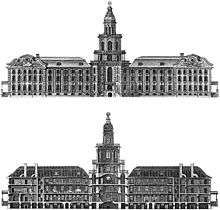Kunstkamera
The Kunstkamera (or Kunstkammer; Russian: Кунсткамера) is the first museum in Russia. Established by Peter the Great and completed in 1727, the Kunstkammer Building hosts the Peter the Great Museum of Anthropology and Ethnography (Russian: Музей антропологии и этнографии имени Петра Великого Российской академии наук), with a collection of almost 2,000,000 items. It is located on the Universitetskaya Embankment in Saint Petersburg, facing the Winter Palace.

History

The Kunstkamera was established by Peter the Great on the Neva Riverfront. The turreted Petrine Baroque building of the Kunstkamera designed by Georg Johann Mattarnovy was completed by 1727. The foundation stone for the Kunstkammer was laid in 1719. The name Kunstkamera is derived from German Kunstkammer, literally meaning "Art chamber".
Peter's museum was a cabinet of curiosities dedicated to preserving "natural and human curiosities and rarities", a very typical type of collection in the period. The tsar's personal collection, originally stored in the Summer Palace, features a large assortment of human and animal fetuses with anatomical deficiencies, which Peter had seen in 1697 visiting Frederick Ruysch and Levinus Vincent. The underlying idea of their kunstkammers was to acquire full knowledge of the world. The Dutch word "kunst-kamer" seems to be introduced by the surgeon Stephanus Blankaart in 1680.
The Kunstkamera of Peter the Great is often seen as a haphazard collection of incoherent rarities, but it seems they were collected systematically subject to a well defined plan. Peter's main interest was in "naturalia", rather than the so-called "artificialia". Peter encouraged research of deformities, all along trying to debunk the superstitious fear of monsters. He issued an ukase ordering malformed, still-born infants to be sent from all over the country to the imperial collection. He subsequently had them put on show in the Kunstkamera as examples of accidents of nature.[1]
In 1716, Peter established the mineral cabinet of Kunstkamera, depositing there a collection of 1195 minerals which he had bought from Gotvald, a Danzig doctor. The collection was enriched with Russian minerals. It was a predecessor of the Fersman Mineralogical Museum, now based in Moscow.
Many items were bought in Amsterdam from pharmacologist Albertus Seba (1716) and anatomist Frederik Ruysch (1717) and formed the basis for the Academy of Sciences. The Kunstkamera was specially built to house these two extensive collections. A third acquisition came from Jacob de Wilde, a collector of gems and scientific instruments. Head-physician to the czar, Robert Erskine, and his secretary Johann Daniel Schumacher were responsible for the acquisition.[2]
Museum of Anthropology and Ethnography
In the 1830s, the Kunstkamera collections were dispersed to newly established imperial museums, the most important being the Peter the Great Museum of Anthropology and Ethnography, established in 1879. It has a collection approaching 2,000,000 items and has been known as the Peter the Great Museum since 1903 (in order to distinguish the older museum from the Russian Museum of Ethnography).
Originally, there were separate museums for anthropology and ethnography, but on 5 December 1878 it was decided to merge them into a single museum with Leopold Schrenk being appointed on 10 November 1879. It was not until 1887 that the museum was finally provided with its own exhibition premises attached to Kunstkamera in Tamozhennyi pereulok. On 23 September 1889, the first exhibition of the unified Museum was opened.
One of the most gruesome exhibits is the head of Willem Mons, brother of Anna Mons. In 1747 some objects were lost in a fire. The museum houses 78 watercolours by the Peruvian artist Pancho Fierro, the largest collection outside Peru. These were brought back by Schrenk following his visit there in 1854.
List of directors
- Leopold Schrenk (1879–94)
- Vasily Radlov (1894–1918)
- Vasily Bartold (1918–21)
- Yefim Karskiy (1921–30)
- Nikolay Matorin (1930–33)
- Ivan Meshchaninov (1934–37)
- Nikolai Kislyakov (1945–48)
- Nikolai Girenko (1991–92)
- Alexander Myl’nikov (1992–97)
- Chuner Taksami (1997–2001)
- Yuri Chistov (2001–present)[3]
See also
- List of museums in Saint Petersburg
- Globe of Gottorf (one of the museum's main artistic pieces)
- Pushkin House (occupied the rooms in the Kunstkamera building in 1905–27)
Notes
- Driessen-Van het Reve, J.J. (2006) De Kunstkamera van Peter de Grote. De Hollandse inbreng, gereconstrueerd uit brieven van Albert Seba en Johann Daniel Schumacher uit de jaren 1711–1752. English summary, pp. 335–336.
- Driessen-Van het Reve, J.J. (2006) De Kunstkamera van Peter de Grote. De Hollandse inbreng, gereconstrueerd uit brieven van Albert Seba en Johann Daniel Schumacher uit de jaren 1711–1752. English summary, pp. 337–338.
- Kunstkamera
Bibliography
- Vladimir Romanovich Arsenyev. 1999. Le musée d'Anthropologie et d'Ethnographie Pierre-le-Grand à Saint-Pétersbourg. Cahiers d'Études africaines 39, no. 155/156: 681–699.
External links
| Wikimedia Commons has media related to Kunstkamera. |